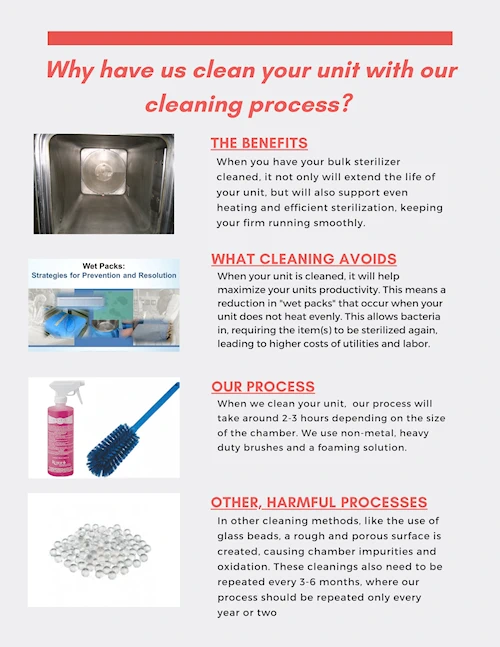Cleaning Your Bulk Sterilizer
Why Professional Cleaning is Essential for Your Bulk Sterilizer
In healthcare, lab, and industrial environments, bulk sterilizers are critical to maintaining clean, sterile equipment and materials. But like any piece of high-performance equipment, sterilizers require proper care and maintenance to function at their best. Regular, professional cleaning of your sterilizer not only extends the life of the unit but also ensures reliable and consistent operation – helping your business avoid costly delays and maintain regulatory compliance.

The Benefits of Routine Sterilizer Cleaning
Cleaning your bulk sterilizer on a regular schedule improves more than just cleanliness – it enhances performance and efficiency. A clean chamber allows for even heating, leading to consistent sterilization cycles. This results in lower energy use, fewer maintenance issues, and overall smoother operations. Investing in a proper cleaning schedule can significantly reduce wear on your equipment and extend its usable life.
Preventing Wet Packs and Costly Reprocessing
One of the most common problems caused by a poorly cleaned sterilizer is the formation of “wet packs.” These occur when residual moisture remains in the sterilization load, often due to uneven heating caused by buildup or contamination inside the chamber. Wet packs can harbor bacteria and usually mean the load must be sterilized again—wasting time, resources, and increasing the risk of cross-contamination. Proper cleaning helps eliminate this issue, keeping your sterilization process safe and efficient.
What to Expect from a Proper Cleaning Process
A thorough cleaning typically takes about 2 to 3 hours, depending on the size and condition of the sterilizer. The process involves using non-metal, heavy-duty brushes and a foaming cleaning solution designed to safely remove buildup without damaging the chamber surface. This approach ensures a deep clean while maintaining the integrity of the sterilizer’s interior, helping it perform as intended without the risk of corrosion or damage.
Avoiding Harmful Cleaning Methods
Not all cleaning methods are created equal. Some services use abrasive materials like glass beads that can leave the chamber with a rough, porous surface. This type of damage can lead to impurities, oxidation, and a shorter equipment lifespan. These aggressive methods also require more frequent repeat cleanings – every 3 to 6 months. In contrast, a gentler, non-abrasive cleaning method typically needs to be repeated only once every 12 to 24 months, saving time and reducing costs in the long run.
Keep Your Equipment Performing at Its Best
Regular, professional cleaning is a simple step that has a big impact. By maintaining your bulk sterilizer properly, you ensure the safety and efficiency of your operations while protecting your investment in expensive equipment. Don’t wait for problems to arise – make professional sterilizer cleaning part of your regular maintenance routine.
